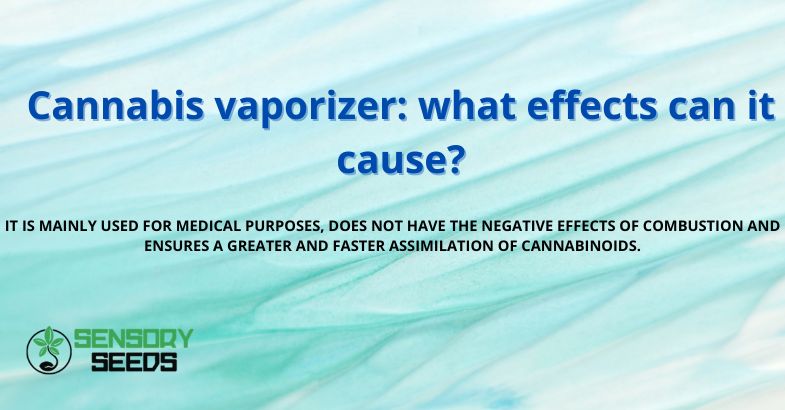Published on: 22/09/2023
IT IS MAINLY USED FOR MEDICAL PURPOSES, DOES NOT HAVE THE NEGATIVE EFFECTS OF COMBUSTION AND ENSURES A GREATER AND FASTER ASSIMILATION OF CANNABINOIDS.
Vaporizing cannabis (not weed seeds) is an alternative to smoking it or taking it through edibles.
This method, mainly used for medicinal purposes, has several advantages, but be careful: the effects are very different from those of other ways of taking cannabis.
Difference between vaping and smoking cannabis effects of heat stress in cannabis
There is a big difference between vaporizing and smoking cannabis. In fact, vaping does not involve burning cannabis, simply heating it to evaporate the cannabinoids such as THC and CBD and terpenes. This avoids all the problems of burning cannabis, such as the production of molecules and other toxic byproducts.
To be clear, THC starts to evaporate at 140° C and evaporates completely at 185° C, while CBD evaporates at 200° C and finishes evaporating at 240° C; combustion, instead, can reach 900° C and release substances that vaporization does not produce, in addition to altering most of the cannabinoids present in cannabis.
Read also: Heat-resistant cannabis: which strains are the most suitable?
Effects and advantages of vaping
Cannabis vaporization (not vaporization of cannabis seeds), as already mentioned, is mainly used in the medical field to treat acute problems, for example when immediate pain relief may be necessary, or if medical cannabis cannot be taken orally (in cases of vomiting or nausea).
In fact, the effects of vaping are practically instantaneous, as it avoids the effects of the first pass through edibles; absorption is also faster than smoking, because the vapor is absorbed earlier by the pulmonary alveoli.
The other advantages, closely related to the effects, are several:


- the elimination of combustion risks;
- a higher efficiency and considerable savings compared to combustion;
- a higher cannabinoid content (approx. 95% compared to 10% when smoking);
- absence of smoke and odor;
- intense flavor;
- from a medical point of view, reduction of respiratory symptoms, for example in the presence of asthma.
Regarding this last point, there are several interesting studies on the benefits of vaporized medical cannabis, which show an improvement of respiratory function values in a few weeks.
That said, it should be made clear that we are talking about legal and/or medical cannabis: vaporization, by increasing the speed and amount of absorption of cannabinoids, can also have some negative effects if done without moderation or good knowledge of dosages and other parameters.
Cannabis vaporizer: appearance and operation
As mentioned above, cannabis vaporizers are mainly used for medical purposes, as they can relieve acute problems in a short time.
Cannabis vaporizers are used to vaporize unprocessed flowers or other plant matter and not waxes, crumbles or extracts.
A vaporizer consists of several components:
Heating chamber, where the cannabis is placed; it is better if it is made of ceramic, as it is a safe material and retains flavors better. There are also quartz heating chambers on the market, which is also a safe material and preserves the flavors better;
Battery: necessary for operation, it can be of various types, removable or fixed. Lithium-ion batteries, for several factors, are the best;
Connecting medium between chamber and mouthpiece: glass is best;
Possible coil to generate heat (best without);
Drip tip: conical, cylindrical or flat, allowing steam suction.
In some cases, vaporizers allow the temperature to be regulated; there are also fixed-temperature vaporizers.
Finally, we can distinguish between conduction and convection vaporizers: conduction vaporizers transfer heat to the cannabis by direct contact.
Convection vaporizers, on the other hand, do not require direct contact but, like ovens, heat the air around the herb to generate vaporization.


How to use the cannabis vaporizer: a few tips
Vaporizing cannabis (from marijuana seeds), as we have seen, can provide benefits (when used with medical cannabis) or, at least, avoid some of the negative effects of burning cannabis (production of a large number of toxins related to combustion).
To use the vaporizer correctly, however, it is good to know the best temperatures for vaporizing cannabinoids and terpenes: for example, the ideal temperature for THC is 157°C, for CBD 170°C, for THC 220°C. Terpenes, on the other hand, work best between 130° (Beta-caryophyllene) and 244° C (Pulegone). In general, a good result can be obtained between 180° C and 210° C.
In addition, it is good to prefer quality cannabis (legal) and, above all, to inhale little each time: as we have said, the assimilation of cannabinoids through the vapor is greater. Preheating the vaporizer is another good practice, as well as taking care of its good maintenance.
In conclusion
Vaporizing cannabis can be more beneficial than smoking it: if it is for medical use, it can provide quick relief from problems such as acute pain and, as some studies have pointed out, even improve certain respiratory functions.
Vaporizers, consisting of a combustion chamber, a battery, a mouthpiece and a channeling medium, are used to create vapor for inhalation; they have the advantage of requiring smaller doses, producing fewer toxic substances and maintaining higher levels of cannabinoids and terpenes.
Of course, in this context we are talking about cannabis for medical or legal use: it is always a good idea to inform yourself thoroughly before using a method such as vaping.
Did you like the article and are you an avid collector of legal cannabis? Welcome among us: check out our SensorySeeds store and choose from auto flowering, feminized and fast flowering seeds, and enrich your collection with top quality products!









